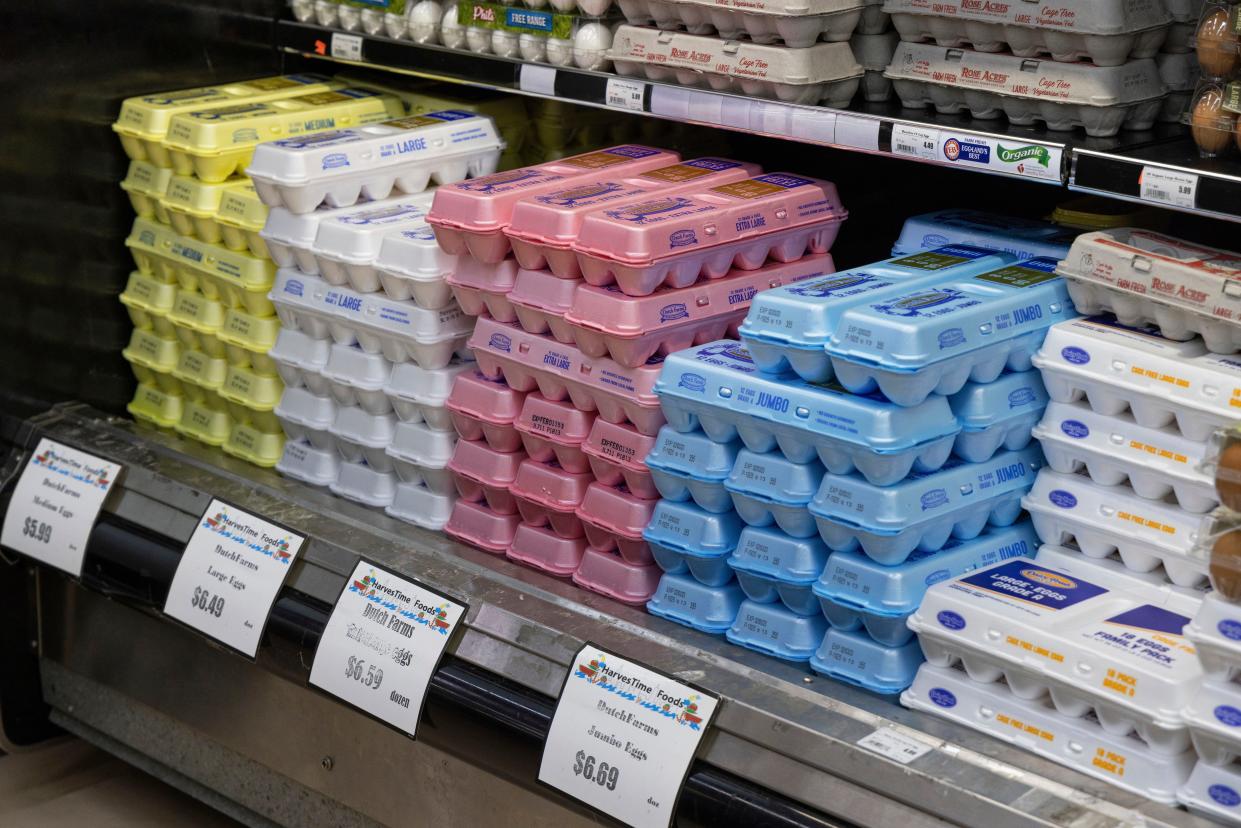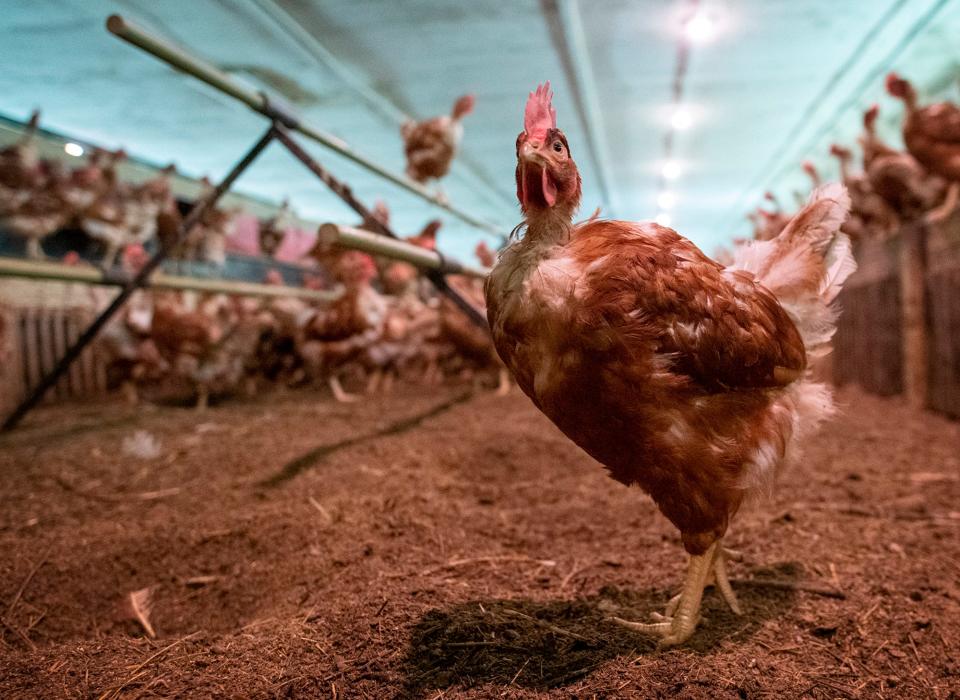Opinion: Will you be able to afford to buy Easter eggs?

Jim Chakeres is the executive vice president for the Ohio Poultry Association.
As one of nature’s most perfect foods, it’s no surprise that eggs can be found in 95% of refrigerators across the country.
More:Egg prices have your wallet hard-boiled? Let these 8 cartoons crack you up
However, consumers have recently felt the burden of increased grocery prices, which unfortunately, also includes eggs.
Despite increased prices, as one of the highest-quality proteins available, eggs remain a great value for all the nutrition benefits they offer. But many are wondering – why are my eggs so expensive?
Increased egg prices are due to many factors that are beyond a farmer’s control – the first being highly pathogenic avian influenza (HPAI), commonly known as the bird flu The bird flu is an infectious disease of birds primarily spread by wild birds and waterfowl and is almost always fatal to hens.
Why are there fewer eggs?
Farmers across the country adhere to stringent biosecurity protocols to prevent transmission of the disease, however, even the best biosecurity is not foolproof, and in 2022, the egg industry faced various bird flu outbreaks.
More:Ohio egg price hikes: Bird flu, feed prices to blame
As such, the U.S. egg farming community has 6% fewer laying hens right now, and although farmers are recovering quickly, egg production has not fully recuperated.
Despite the impact of bird flu, consumer demand remains steady, and farmers are focused on protecting their birds and keeping grocery stores stocked.
In fact, most egg farms affected by bird flu this year have recovered and are back to producing eggs. It’s also important to know that farmers can’t usually set the price of their eggs. Like most products, the price is reliant on the market, supply and demand.
Aside from the bird flu, increased prices reflect several other factors like inflation on input costs, labor and supply chain challenges.
In Ohio and across the country, one of the leading input costs to raise chickens is feed. In the current market, feed prices are also on the rise, which again, affects retail prices on eggs. However, it’s relieving to know that the December Consumer Price Index shows inflation is cooling – which is good news for the egg case.
Where do we go from here?

Across the country, there are 300 million egg-laying hens, which equals one chicken for every American.
So even as supply may be temporarily tight, our egg supply overall is robust, and our farmers are doing all they can to keep eggs readily available and grocery store shelves stocked.
With Easter on the horizon, egg farmers are focused on making sure there are plenty of eggs at a great value to meet that coming demand.
Although no one can predict exactly when prices will come down, experts all say current prices are temporary.
Egg prices have been dropping in January from their record highs in December, due in part to the end of holiday baking season and egg production increases. It is important to know that any low-stocks or shortages are sporadic and shouldn’t last long.
As we look ahead, egg lovers can rest assured that our farmers are working around the clock to meet demand and keep eggs plentiful.
Jim Chakeres is the executive vice president for the Ohio Poultry Association.
Why Are My Eggs So Expensive?
As one of nature’s most perfect foods, it’s no surprise that eggs can be found in 95% of refrigerators across the country. However, consumers have recently felt the burden of increased grocery prices, which unfortunately, also includes eggs. Despite increased prices, as one of the highest-quality proteins available, eggs remain a great value for all the nutrition benefits they offer. But many are wondering – why are my eggs so expensive?
Increased egg prices are due to many factors that are beyond a farmer’s control – the first being highly pathogenic avian influenza (HPAI), commonly known as the bird flu. The bird flu is an infectious disease of birds primarily spread by wild birds and waterfowl and is almost always fatal to hens. Farmers across the country adhere to stringent biosecurity protocols to prevent transmission of the disease, however, even the best biosecurity is not foolproof, and in 2022, the egg industry faced various bird flu outbreaks. As such, the U.S. egg farming community has 6% fewer laying hens right now, and although farmers are recovering quickly, egg production has not fully recuperated.
This guest column is available free: Support the exchange of local and state ideas by subscribing to the Columbus Dispatch.
Despite the impact of bird flu, consumer demand remains steady, and farmers are focused on protecting their birds and keeping grocery stores stocked. In fact, most egg farms affected by bird flu this year have recovered and are back to producing eggs. It’s also important to know that farmers can’t usually set the price of their eggs. Like most products, the price is reliant on the market, supply and demand.
Aside from the bird flu, increased prices reflect several other factors like inflation on input costs, labor and supply chain challenges. In Ohio and across the country, one of the leading input costs to raise chickens is feed. In the current market, feed prices are also on the rise, which again, affects retail prices on eggs. However, it’s relieving to know that the December Consumer Price Index shows inflation is cooling – which is good news for the egg case.
Where do we go from here?

Across the country, there are 300 million egg-laying hens, which equals one chicken for every American. So even as supply may be temporarily tight, our egg supply overall is robust, and our farmers are doing all they can to keep eggs readily available and grocery store shelves stocked. With Easter on the horizon, egg farmers are focused on making sure there are plenty of eggs at a great value to meet that coming demand.
Although no one can predict exactly when prices will come down, experts all say current prices are temporary. Egg prices have been dropping in January from their record highs in December, due in part to the end of holiday baking season and egg production increases. It is important to know that any low-stocks or shortages are sporadic and shouldn’t last long.
As we look ahead, egg lovers can rest assured that our farmers are working around the clock to meet demand and keep eggs plentiful.
Jim Chakeres is the executive vice president for the Ohio Poultry Association.
This article originally appeared on The Columbus Dispatch: Jim Chakeres: When will the price of eggs drop? Ohio Poultry Association.

